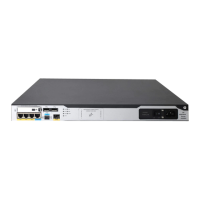261
Enabling MLD
Enable MLD on the interface on which IPv6 multicast group memberships are created and maintained.
To enable MLD:
Ste
Command Remarks
1. Enter system view.
system-view N/A
2. Enable IPv6 multicast routing
and enter IPv6 MRIB view.
ipv6 multicast routing [ vpn-instance
vpn-instance-name ]
By default, IPv6
multicast routing is
disabled.
3. Return to system view.
quit N/A
4. Enter interface view.
interface interface-type interface-number N/A
5. Enable MLD.
mld enable
By default, MLD is
disabled.
Specifying the MLD version
Because MLD message types and formats vary with MLD versions, configure the same MLD version for all
routers on the same subnet. Otherwise, MLD cannot operate correctly.
To specify an MLD version:
Ste
Command Remarks
1. Enter system view.
system-view
N/A
2. Enter interface view.
interface interface-type
interface-number
N/A
3. Configure an MLD version on
the interface.
mld version version-number The default setting is MLDv1.
Configuring an interface as a static member interface
To test IPv6 multicast data forwarding, you can configure an interface as a static member of an IPv6
multicast group. Then, the interface can always receive IPv6 multicast data addressed to the IPv6
multicast group.
Configuration guidelines
• A static member interface has the following restrictions:
{ If the interface is MLD and IPv6 PIM-SM enabled, it must be an IPv6 PIM-SM DR.
{ If the interface is MLD enabled but not IPv6 PIM-SM enabled, it must be an MLD querier.
For more information about IPv6 PIM-SM and DR, see "Configuring IPv6 PIM."
• A static member interface does not respond to queries from the MLD querier. When you configure
an interface as a static member interface or cancel this configuration, the interface does not send
any MLD report or an MLD done message without a request. This is because the interface is not a
real member of the IPv6 multicast group or the IPv6 multicast source and group.

